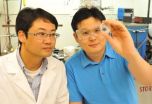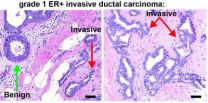(Press-News.org) At a time when obesity, type 2 diabetes, and their complications are a veritable epidemic worldwide, researchers at the University of Montreal and CHUM Research Centre (CRCHUM) recently demonstrated the potential of retinoic acid (RA), a derivative of Vitamin A, in treating obesity and type 2 diabetes and preventing their cardiovascular complications. The findings were presented June 6, 2014 at the Annual Conference of the Canadian Nutrition Society in Saint John's, Newfoundland.
"In obese and insulin resistant mice, retinoic acid reduces the risk of cardiac apoptosis, stimulates the expression of cardio-protective genes reduced by the disease, and protects against the accumulation of collagen in the cardiac muscle, thus avoiding the occurrence of fibrosis and possible associated future complications," says the first author of the study, Daniel-Constantin Manolescu. Apoptosis is the process of programmed cell death. The discovery follows other research conducted by his team on the effects of RA on insulin resistance, diabetes, and obesity. "Blood glucose, insulin resistance, body weight, and adipocyte size were significantly decreased in treated animals, including abdominal fat, while dietary intake and physical activity were similar for treated or non-treated animals. This suggests an increase in basal energy expenditure," says Manolescu.
White fat is an energy reserve formed by the accumulation of fat in the form of triglycerides to meet unexpected increases in energy costs, but it is also a hormonal tissue with a delicate balance. Overall, if energy intake is greater than expenditures over an extended period, obesity increases, while hormonal balance and energy metabolism are disturbed. In this context, resistance to type 2 diabetes develops over time.
Brown fat also stores triglycerides, but it has the ability to produce heat. Abundant in babies, brown fat does not disappear completely in adulthood. It is irrigated by blood vessels and has many mitochondria, the energy factories of cells. Vitamin A derivatives stimulate a mitochondrial uncoupling protein (UCP1) that allows uncoupling of the mitochondria pathway (oxidative phosphorylation ), which uses energy from the oxidation of nutrients for the production of adenosine triphosphate (ATP). For a period of time, they generate heat (thermogenesis) instead of ATP, which is traditionally the energy required for active metabolism. Exposure to cold leads to the stimulation of brown fat and white fat, promoting the conversion of triglycerides to free fatty acids and glycerol. However, in brown adipocytes, these fatty acids are rapidly oxidized in the mitochondria and produce heat (under the influence of the UCP1 protein). Brown fat thus helps to increase basal energy metabolism. As a result, hibernating mammals fatten in the fall without developing diabetes and lose weight without moving too much in the winter (while warming their den). They are also the animals that accumulate the most Vitamin A in their livers. Retinoic acid (a Vitamin A derivative) is recognized for its involvement in cell maturation and differentiation and may guide pre-adipocytes to become brown (or beige) instead of white. It is as if "boilers" were installed directly in reserves of white fat to melt it on the spot and prevent it from over-accumulating.
"Vitamine A is a bioactive nutrient. The originality of our project is in addressing obesity and type 2 diabetes through the involvement of retinoids. We have attracted international attention and were named among 12 teams in the world to bring conclusive data in this regard," says Dr. Pangala V. Bhat.
"Our studies on animals show that retinoic acid induces normalization of blood glucose and reduction of obesity. It is an important contribution to understanding RA action on the liver, fat, muscles, and the heart, and on retinoid metabolism, energy metabolism, fatty acid oxidation, and insulin resistance. Our research identifies new metabolic effects of retinoids and may lead to anti-obesity and anti-diabetic medicines," says Dr. Jean-Louis Chiasson.
INFORMATION:
Note
The University of Montreal is officially known as Université de Montréal.
About the poster
The first author, Daniel-Constantin Manolescu was chosen first place among eight finalists in the 2014 national scientific abstract competition for student members of the Canadian Nutrition Society. He presented his scientific poster June 6, 2014 in Saint John's, Newfoundland. The findings were also published in Applied Physiology Nutrition and Metabolism-NRC.
About the team
Dr. Jean-Louis Chiasson, Professor in the Departments of Medicine and Nutrition at the Université de Montréal and Head of Endocrinology at the CHUM (supervisor), Dr. V. Bhat Pangala (co-supervisor), Aurelia Sima (PhD candidate – Nutrition), Daniel-Constantin Manolescu (PhD candidate – Nutrition).
About Daniel-Constantin Manolescu
Daniel-Constantin Manolescu joined the Department of Nutrition of the University of Montreal's Faculty of Medicine following studies in Food Sciences at the University of Galati (Romania) and in Physiology/Endocrinology at CNRS/Musée d'Histoire Naturelle Paris and Université de Paris 7 (France). He is pursuing his doctorate (PhD) in partnership with CHUM Research Centre (CRCHUM). In 2012, he received the CIHR/CHRSF Silver Medal for Canadian scientific research and is currently a recipient of a doctoral scholarship from the Banting and Best Foundation.
References of cited publications:
1) "Natriuretic peptide and other cardio-protective genes are stimulated by Vitamin A (retinoid acid), preventing apoptosis and fibrosis in obese-diabetic mice heart" (Manolescu et al., 2014). Collaboration between the laboratoires of Dr. Jean-Louis Chiasson and Dr. Jolanta Gutkowska, CRCHUM.http://www.nrcresearchpress.com/doi/abs/10.1139/apnm-2014-0005
2) "All-trans retinoic acid lowers serum retinol-binding protein 4 concentrations and increases insulin sensitivity in diabetic mice" (Manolescu et al. 2010). http://www.ncbi.nlm.nih.gov/pubmed/20032483
Vitamin A derivative potentially treats type 2 diabetes and prevents its complications
2014-06-16
ELSE PRESS RELEASES FROM THIS DATE:
Researchers use virus to reveal nanopore physics
2014-06-16
PROVIDENCE, R.I. [Brown University] — Nanopores may one day lead a revolution in DNA sequencing. By sliding DNA molecules one at a time through tiny holes in a thin membrane, it may be possible to decode long stretches of DNA at lightning speeds. Scientists, however, haven't quite figured out the physics of how polymer strands like DNA interact with nanopores. Now, with the help of a particular type of virus, researchers from Brown University have shed new light on this nanoscale physics.
"What got us interested in this was that everybody in the field studied DNA and ...
Strokefinder quickly differentiates bleeding strokes from clot-induced strokes
2014-06-16
The results from the initial clinical studies involving the microwave helmet Strokefinder confirm the usefulness of microwaves for rapid and accurate diagnosis of stroke patients. This is shown in a scientific article being published on June 16. Strokefinder enables earlier diagnosis than current methods, which improves the possibility to counteract brain damage.
In the article, researchers from Chalmers University of Technology, Sahlgrenska Academy and Sahlgrenska University Hospital present results from the initial patient studies completed last year. The study included ...
E-cigarettes far less harmful than cigarettes, says researcher at INFORMS Conference
2014-06-16
A London School of Economics researcher examining the public and private dangers of drugs argues against demonizing e-cigarettes in a presentation being given at a conference of the Institute for Operations Research and the Management Sciences (INFORMS). He also calls on public officials to recognize that alcohol causes greater harm than other recreational drugs and more public attention should be paid to controlling its harmful effects.
Lawrence D. Phillips, an emeritus professor at the London School of Economics, will present his research group's findings about the relative ...
Most millennial moms who skip college also skip marriage
2014-06-16
Waiting until marriage to have babies is now "unusual" among less-educated adults close to 30 years old, Johns Hopkins University researchers found.
"Clearly the role of marriage in fertility and family formation is now modest in early adulthood and the lofty place that marriage once held among the markers of adulthood is in serious question," sociologist Andrew J. Cherlin said. "It is now unusual for non-college graduates who have children in their teens and 20s to have all of them within marriage."
Among parents aged 26 to 31 who didn't graduate from college, 74 ...
Regenerating our kidneys
2014-06-16
Doctors and scientists have for years been astonished to observe patients with kidney disease experiencing renal regeneration. The kidney, unlike its neighbor the liver, was universally understood to be a static organ once it had fully developed.
Now a new study conducted by researchers at Sheba Medical Center, Tel Aviv University and Stanford University turns that theory on its head by pinpointing the precise cellular signalling responsible for renal regeneration and exposing the multi-layered nature of kidney growth. The research, in Cell Reports, was conducted by principal ...
WSU researchers develop fuel cells for increased airplane efficiency
2014-06-16
PULLMAN, Wash.–Washington State University researchers have developed the first fuel cell that can directly convert fuels, such as jet fuel or gasoline, to electricity, providing a dramatically more energy-efficient way to create electric power for planes or cars.
Led by Professors Su Ha and M. Grant Norton in the Voiland College of Engineering and Architecture, the researchers have published the results of their work in the May edition of Energy Technology. A second paper on using their fuel cell with gasoline has been accepted for publication in the Journal of Power ...
Sleep quality and duration improve cognition in aging populations
2014-06-16
EUGENE, Ore. -- (June 16, 2014) -- Maybe turning to sleep gadgets -- wristbands, sound therapy and sleep-monitoring smartphone apps -- is a good idea. A new University of Oregon-led study of middle-aged or older people who get six to nine hours of sleep a night think better than those sleeping fewer or more hours.
The study, published in the June issue of the Journal of Clinical Sleep Medicine, reaffirms numerous small-scale studies in the United States, Western Europe and Japan, but it does so using data compiled across six middle-income nations and involving more than ...
Tugging on the 'malignant' switch
2014-06-16
Cambridge, Mass. – June 16, 2014 – A team of researchers led by David J. Mooney, Robert P. Pinkas Family Professor of Bioengineering at the Harvard School of Engineering and Applied Sciences, have identified a possible mechanism by which normal cells turn malignant in mammary epithelial tissues, the tissues frequently involved in breast cancer.
Dense mammary tissue has long been recognized as a strong indicator of risk for breast cancer. This is why regular breast examinations are considered essential to early detection. Until now, however, the significance of that tissue ...
Sensor in eye could track pressure changes, monitor for glaucoma
2014-06-16
Your eye could someday house its own high-tech information center, tracking important changes and letting you know when it's time to see an eye doctor.
University of Washington engineers have designed a low-power sensor that could be placed permanently in a person's eye to track hard-to-measure changes in eye pressure. The sensor would be embedded with an artificial lens during cataract surgery and would detect pressure changes instantaneously, then transmit the data wirelessly using radio frequency waves.
The researchers recently published their results in the Journal ...
LLNL researchers develop high-quality 3-D metal parts using additive manufacturing
2014-06-16
LIVERMORE, Calif. – Lawrence Livermore National Laboratory researchers have developed a new and more efficient approach to a challenging problem in additive manufacturing -- using selective laser melting, namely, the selection of appropriate process parameters that result in parts with desired properties.
Selective laser melting (SLM) is a powder-based, additive manufacturing process where a 3D part is produced, layer by layer, using a high-energy laser beam to fuse the metal powder particles. Some SLM applications require parts that are very dense, with less than ...




